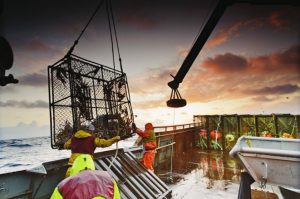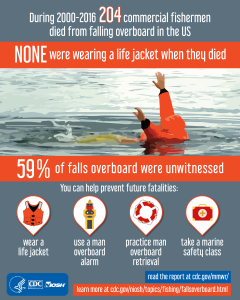Fatal Falls Overboard in Commercial Fishing
Posted on by April 28th is Workers’ Memorial Day where we remember those who have lost their lives while trying to make a living. The current issue of the Centers for Disease Control and Prevention’s Morbidity and Mortality Weekly Report (MMWR) includes workplace fatality, injury and illness data; a QuickStats which demonstrates differences among employment categories in influenza vaccination; and the article summarized in this blog, “Fatal Falls Overboard in Commercial Fishing — United States, 2000–2016.” Commercial fishing is one of the most dangerous jobs in the United States, with a work-related fatality rate 23 times higher than for all workers in 2016 1. Falling from a fishing vessel is a serious hazard responsible for the second highest number of fatalities in the industry after vessel sinking events 2, 3. The National Institute for Occupational Safety and Health (NIOSH) analyzed data on unintentional fatal falls overboard in the US commercial fishing industry to identify gaps in the use of prevention strategies. NIOSH researchers examined each fall overboard to determine the circumstances of the fall, including worker activity, primary cause, and contributing factors. Recovery attempts were also considered, noting any use of survival or rescue equipment and administration of medical treatment.
April 28th is Workers’ Memorial Day where we remember those who have lost their lives while trying to make a living. The current issue of the Centers for Disease Control and Prevention’s Morbidity and Mortality Weekly Report (MMWR) includes workplace fatality, injury and illness data; a QuickStats which demonstrates differences among employment categories in influenza vaccination; and the article summarized in this blog, “Fatal Falls Overboard in Commercial Fishing — United States, 2000–2016.” Commercial fishing is one of the most dangerous jobs in the United States, with a work-related fatality rate 23 times higher than for all workers in 2016 1. Falling from a fishing vessel is a serious hazard responsible for the second highest number of fatalities in the industry after vessel sinking events 2, 3. The National Institute for Occupational Safety and Health (NIOSH) analyzed data on unintentional fatal falls overboard in the US commercial fishing industry to identify gaps in the use of prevention strategies. NIOSH researchers examined each fall overboard to determine the circumstances of the fall, including worker activity, primary cause, and contributing factors. Recovery attempts were also considered, noting any use of survival or rescue equipment and administration of medical treatment.
Results
During 2000-2016, 204 commercial fishermen died from unintentionally falling overboard. The study found that fatalities occurred most frequently on the East Coast (30%), followed by the Gulf of America (29%), Alaska (25%), and the West Coast (13%). The remaining five deaths occurred off Hawaii. The type of fishing operations with the highest number of fall overboard deaths were: Gulf of America shrimp (34), East Coast lobster (18), Alaska salmon drift gillnet (16), and East Coast scallop (10).
 Many falls occurred while crewmembers were working on deck with fishing gear, including 35 falls while setting gear and 20 falls while hauling gear onboard. Thirty-four falls also occurred while crewmembers were on deck while off duty. The leading causes of falls were losing balance (32%), tripping or slipping (32%), and becoming entangled in gear (21%). The most commonly identified contributing factors included working alone (49%), alcohol and/or drug involvement (18%), and inclement weather (12%).
Many falls occurred while crewmembers were working on deck with fishing gear, including 35 falls while setting gear and 20 falls while hauling gear onboard. Thirty-four falls also occurred while crewmembers were on deck while off duty. The leading causes of falls were losing balance (32%), tripping or slipping (32%), and becoming entangled in gear (21%). The most commonly identified contributing factors included working alone (49%), alcohol and/or drug involvement (18%), and inclement weather (12%).
None of the victims wore a personal flotation device (PFD) when they died. A life ring was used in 19 events but most often did not result in a successful recovery of the person in the water. A man-overboard alarm was only reportedly used in one event. The majority of falls were not witnessed, and most of these fishermen were not found in the ensuing search. Of the 30 total crewmembers who were recovered from the water within an hour, CPR was attempted on 21 to no avail.
Prevention and Next Steps
Preventing falls overboard is a priority area in fishing safety. A variety of strategies can be implemented to prevent crewmembers from falling from a vessel, including: creating enclosed workspaces; raising the gunnels on the vessel; and using lifelines and tethers where possible. Because fishing operations differ, workers in some fisheries are more exposed to entanglement hazards than others, especially if they work with lines while setting gear. Engineering controls, such as line bins, can help control hazards by reducing the amount of line on deck. In addition, enforcing drug and alcohol-free policies on vessels might reduce the likelihood of crewmembers unintentionally falling overboard.
A striking finding from this study is that none of the victims were wearing a PFD when they died. Without flotation, victims can drown within minutes after immersion in cold water from cold-shock responses and limited swimming ability. Although regulations mandate commercial fishing vessels carry a PFD for each crewmember, there are no requirements for fishermen to wear them while working Many fishermen recognize the effectiveness of PFDs to prevent drownings, yet concerns regarding discomfort, cost, work interference, and potential for entanglement hinder widespread adoption throughout the industry . Comfortable and workable PFDs are available that can alleviate these concerns, and one manufacturer has even developed a flotation vest based on feedback from fishermen. See the NIOSH campaign “Live to be Salty” which encourages PFD usage.
The majority of fatal falls overboard in this study were not observed, likely resulting in search and rescue delays and reducing the chances of a successful recovery. A man-overboard alarm worn by a worker that relays to the remaining crewmembers or even nearby vessels that a fall overboard occurred, can enable prompt rescue efforts. Use of this technology has not been widely adopted by the fishing industry, despite its potential to save lives and be incorporated into work gear.
The difficulty of retrieving a person from the water was underscored in this study. Although rescue attempts were made within one hour for 69 victims, over half were unsuccessful. Effective recovery devices, such as lifting slings, can provide additional flotation and help hoist the person back onto the vessel. By participating in marine safety training and drills, crewmembers will be prepared to respond to a man overboard event. Fishermen who work alone face additional challenges and should have ladders and engine shutoff devices available to facilitate re-boarding.
Timely treatment of a fall overboard victim, including performing CPR, preventing further heat loss, and rewarming the victim, is a priority. None of the 30 crewmembers who were recovered back onboard within one hour were revived. Successful treatment might be more likely if professional medical assistance is obtained as soon as possible. However, this is a challenge for much of the fishing industry when operating in remote locations.
On average, the number of falls overboard decreased by 3.9% annually from 2000-2016. While this overall decline is encouraging, these events remain a leading contributor to commercial fishing deaths and are largely preventable. The implementation of prevention strategies by vessel owners as discussed above could likely continue this positive trend and enable these workers to stay safe while working at sea.
We would like to hear from you. Tell us how you have encouraged the use of PFDs on commercial fishing vessels.
Samantha Case, MPH, is an epidemiologist in the NIOSH Western States Division.
For More Information:
The NIOSH Commercial Fishing Safety Topic Page
Fishing Safety Success Story: My Life Vest Saved Me
A Story of Impact: PFD Manufacturer Adopts NIOSH Research into Product Development Process
Assessment of Safety in the Bering Sea/Aleutian Island Crab Fleet
Reducing Winch Entanglements with Auxiliary-stop Device
Reducing Winch Entanglements with Stationary Guarding
References
- Bureau of Labor Statistics. Injuries, illnesses, and fatalities: Census of Fatal Occupational Injuries (CFOI) – current and revised data. Washington, DC: US Department of Labor, Bureau of Labor Statistics; 2017. https://www.bls.gov/iif/oshcfoi1.htm.
- Lincoln JM, Lucas DL. Occupational fatalities in the United States commercial fishing industry, 2000-2009. J Agromedicine. 2010 Oct;15(4):343-50.
- Lucas DL, Case SL. Work-related mortality in the US fishing industry during 2000-2014: New findings based on improved workforce exposure estimates. Am J Ind Med. 2018 Jan;61(1):21-31.
Posted on by

